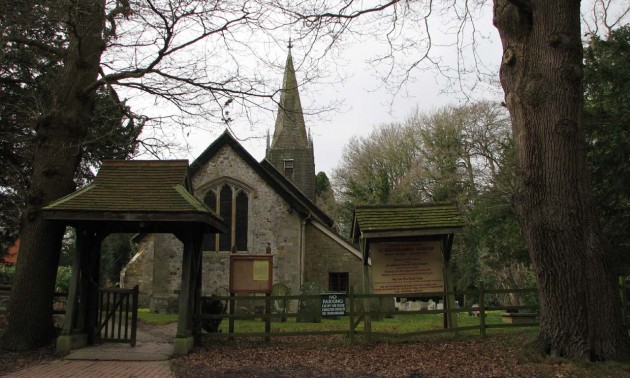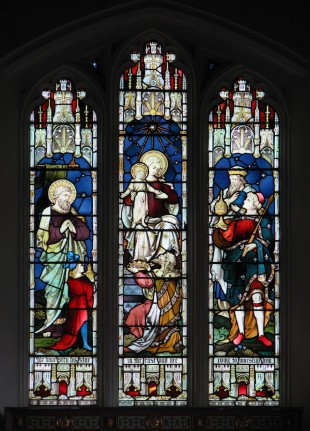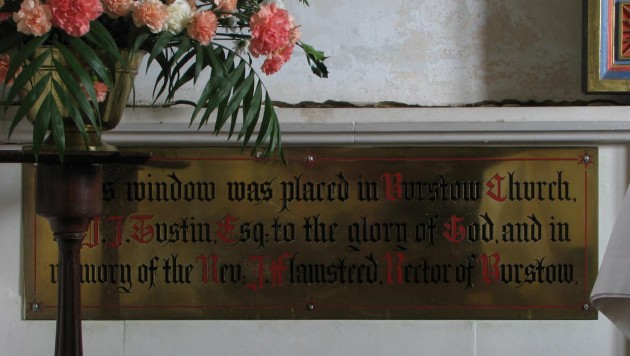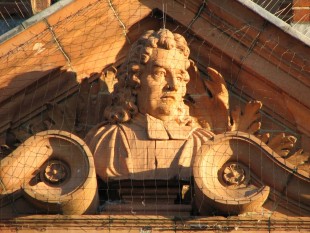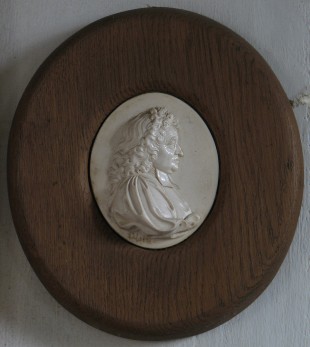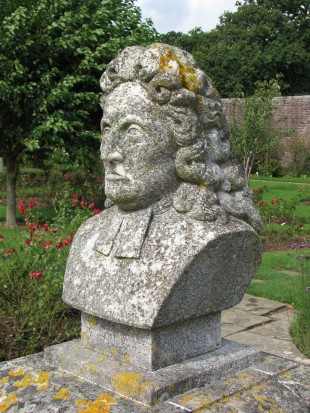…where east meets west
- Home
- Brief History
- The Greenwich Meridian
- Greenwich
(1675–1958) - Herstmonceux
(1948–1990) - Cambridge
(1990–1998) - Outstations (1822–1971)…
- – Chingford (1822–1924)
- – Deal
(1864–1927) - – Abinger
(1923–1957) - – Bristol & Bradford on Avon
(1939–1948) - – Bath
(1939–1949) - – Hartland
(1955–1967) - – Cape of Good Hope
(1959–1971)
- Administration…
- – Funding
- – Governance
- – Inventories
- – Pay
- – Regulations
- – Royal Warrants
- Contemporary Accounts
- People
- Publications
- Science
- Technology
- Telescopes
- Chronometers
- Clocks & Time
- Board of Longitude
- Libraries & Archives
- Visit
- Search
The burial place of John Flamsteed the first Astronomer Royal
As well as being the first Astronomer Royal, John Flamsteed was also Rector of Burstow from 1684 until his death at the end of 1719. His predecessor as Rector was his grand-father in law Ralph Cooke and his successor, James Pound, the uncle of the third Astronomer Royal, James Bradley. Although Flamsteed died in Greenwich at the Royal Observatory, he was taken to Burstow to be buried, the parish records indicating that he was interred there on 12 January 1720.
| Dates in office: | 1675–1719 | |
| Born: | 1646, August 19 |
|
| Died: | 1719, December 31 (at the Royal Observatory) |
|
| Buried at: | St Bartholemew's Church, Church Road, Burstow, Surrey, RH6 9RG |
|
| Date interred: | 12 January 1720 | |
| Tomb details: | Burried in an unmarked grave below the chancel |
|
| Memorial plaques etc: | 1. East window with brass dedication plaques on left and right beneath. |
|
| 2. Tablet with circular medallion beneath list of rectors on south wall of chancel | ||
| 3. Ceramic cameo and poster telling the story of Flamseed’s life at west end of church |
||
| Church website | http://www.windmillchurches.co.uk/burstow-church | |
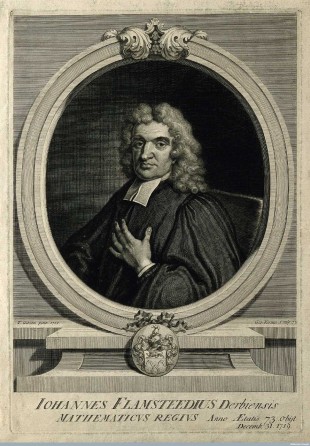
John Flamsteed. Line engraving by G. Vertue, 1721, after T. Gibson, 1712. Copyrighted work reproduced courtesy of Wellcome Library, London under the terms of a Creative Commons Attribution only licence CC BY 4.0 (see below)
The first published reference comes from Maskelyne’s assistant Thomas Evans, who worked at the Observatory from 1796–98. In his article about the Observatory that was included in John Evans’ book, The Juvenile tourist (first published in 1804), he was to write of Flamsteed:
‘He died, 19th [31st] December, 1719, aged 73, and lies buried in the church-yard of Burstow, near East Grinstead, in Surr[e]y, the living of which was presented to him about the year 1684. After very diligent search and enquiry no remains of any tomb or monument to his memory can be found: nor does any one in the place know in what part of the church-yard he was buried.’
In 1866, one of Airy’s assistants, James Carpenter, wrote a series of four articles about the Observatory for the Gentleman’s Magazine (click here to read them). He too discovered during the course of his research that not only was there no gravestone or memorial at the church, but there appeared to be no record of exactly where Flamsteed had been buried either. This caused him to write (p.246):
And what of Flamsteed? Where is his resting-place and his monument? Must we say that the former is scarcely known, and that nothing in shape of the latter exists? Such is the fact. It is curious that his biographers make scarce any mention of the deposit of his mortal remains. Thinking it most probable that they were interred in the churchyard of the parish of his ministry, we lately visited Burstow, with the hope of finding some tombstone or monument to his memory. We found none. The present rector kindly informed us that there is an entry in the parish register to the effect that John Flamsteed was buried on Jan. the 12th, 1720, and that a tradition exists that he was laid beneath the chancel of the church, beside Dr. Cooke (possibly his father-in-law), but that no monument or tablet has ever existed; not even is his name inscribed upon the stone that covers his bones. Neglected in life, he has been forgotten in death. Yet not quite forgotten; for his name, familiar to astronomers as a household word, has cause to be remembered and revered by a few at least of the poor and needy of his parish. He left to that parish "the interest of 25 l[ivres]. per annum, to purchase two new coats for two poor Christian people; " and his faithful widow, following his good example, bequeathed the like amount, "to buy two new gowns and petticoats for two poor widows."
His contemporary, Newton, who owed some of the basis of his fame to Flamsteed’s assistance, has been portrayed, sculptured, and monumented to sufficiency; and the tomb of Halley – Flamsteed’s enemy and successor in office – in Lee churchyard was, some ten years ago, restored at the Government expense. Could not a few pounds be spared from the public purse to erect some slight tribute to our hero’s memory? Or, failing that, could not a few shillings be granted to inscribe the name of “John Flamsteed, England’s first Royal Astronomer,” on that blank slab in the chancel of Burstow church?
In 1880, another of Airy’s Assistants, William Lynn, who had just retired on grounds of ill health, took it upon himself to visit Burstow and see for himself where Flamsteed had been buried. This prompted Edwin Dunkin, another assistant at the Observatory, who in his spare time was something of an antiquary, to investigate further. In 1881 shortly before Airy’s retirement, he wrote a letter that was published in The Observatory (a journal of astronomy) with his findings. Much of this is transcribed below (Click here to read it in full):
Believing that any circumstances, however trivial, relating to the personal history of the Rev. John Flamsteed will be received with interest, I have thought that the readers of the ‘Observatory,’ and astronomers generally, will be glad to be informed of a few facts lately come into my possession, which clear up a doubtful point regarding the resting-place of the remains of the first Astronomer Royal. These facts have been gleaned principally from the registered copy of the will of Mrs. Margaret Flamsteed, his widow, now preserved in the Principal Registry of the Court of Probate, Somerset House.
Flamsteed died at the Royal Observatory on 1719, December 31; and in the parish register of Burstow, in Surrey, the record of his burial is entered thus : – " 1719-20. Jan: ye 12th. The Revd Mr. John Flamsteed, Rector of this Parish.” Up to the present time there appears to have been some uncertainty as to the locality or his grave, whether it was in the chancel or the churchyard. There was no known documentary evidence one way or the other; but it has always been supposed to be in the chancel; and a tradition, brought down probably from rector to rector, has assigned a place for it there next to that of Flamsteed’s predecessor, Dr. Cooke.
Mr. J. Carpenter, in his interesting account of Flamsteed, published in the ‘Gentleman’s Magazine,’ February–April 1866, commenting on the paucity of information we possess, remarks: “And what of Flamsteed ? … … but that no monument or tablet has ever existed; not even is. his name inscribed upon the stone that covers his bones."
To this interesting statement of Mr. Carpenter, I may add that Mr. Lynn has more recently visited Burstow church, and was informed by the present rector, the Rev. T. B. Sikes, that all that is known of Flamsteed’s grave in the parish is, that it is believed that he was interred by the side of his relative, Dr. Cooke, but that there is no memorial of him further than the brief record of his burial inserted in the parish register.
The following extract from Mrs. Flamsteed’s will, dated Dec. 3, 1728, clearly shows that the Burstow tradition is founded on fact, and that the remains of the astronomer do really lie in the chancel and not in the churchyard. “Item. I doe hereby order and direct that I be buryed in the same Grave in which Mr. John Flamsteed is buryed in the Chancell of Burstow Church, in the County of Surry, and I doe further order and direct that I shall be inclosed in a Leaden Coffin for which and another Coffin to inclose the former I assigne ten pounds. I further order and direct that my Executor (if it please God I doe not live to doe it myself) doe cause to be placed in the aforesaid Chancell of Burstow in Surry, a Marble Stone or Monument with an inscription in Latin, in memory of the late Reverend Mr. John Flamsteed, and I allow twenty five pounds for the Expence of it. I would have my own Interrment mentioned in that Inscription." (Registered Copy, 189 Auber.)
Here we have not only positive evidence of the interment of Flamsteed in the chancel of Burstow church, but we are also informed that decided testamentary instructions were given by his widow that a suitable memorial with an inscription should be erected over his remains. Why the executor, Mr. John Hodgson, failed to carry out the expressed wishes of Mrs. Flamsteed must be left as a matter of conjecture. Ample funds were left by the testatrix, as we may gather from the numerous legacies bequeathed, some of which were of considerable amount. A legacy of twenty-five pounds, for the purchase annually of two gowns and petticoats for two poor women of the parish of Burstow, was duly paid to the rector, as is recorded on a tablet in the church. It is clear that the monument was never erected, as it would be extremely improbable that one of the nature of that described in the will would have totally disappeared from the chancel, while that of Dr. Cooke, of older date, is still in good preservation. We can come to no other conclusion than that the executor, who was the residuary legatee, either wilfully or carelessly neglected his duty. Probably the erection of the monument was deferred from year to year till the subject was forgotten altogether. That the executor was dilatory in carrying out the terms of the will, in which there were no deferred trusts affecting the executor, may be assumed from the following entry, dated 23 Dec. 1751, on the margin of the registered copy of the will, more than twenty-one years after the death of Mrs. Flamsteed : – “Administration with will annexed of the goods, chattels, and credits of Margaret Flamsteed, late of East Greenwich, co. Kent, widow, deceased, left unadministered by John Hodgson, the sole executor and residuary legatee, granted to John Tew, the sole executor and residuary legatee named in the will of the said John Hodgson, deceased.”
Dunkin’s letter to The Observatory was followed up by one from Lynn that was published in November 1886. In this, he stated that at the time when he had visited the church in 1880, the Rector had told him that a restoration of the church was being contemplated. At that time Lynn had wondered if the slab covering Flamsteed’s grave might have been at some point turned over. Work carried out during the restoration indicated that it had not. Indeed a thorough search was made of the chancel when the stones were up, but nothing was found to prove the fact that Flamsteed had been buried there. Click here to read the letter as published.
Nothing further happened until a letter was published in The Times on 3 June 1892 giving details of a memorial that was being planned for the American James Russell Lowell in the Chapter House of Westminster Abbey. This spurred, William Tebb, a businessman and social reformer, who had moved to Burstow in the late 1880s, into action on Flamsteed’s behalf. After gaining support from the Astronomer Royal, William Christie, and the Astronomer Royal for Ireland, Sir Robert Ball, he wrote to The Times on 19 August making the point that if a memorial was to be erected to an American at Westminster Abbey, then surely it was time to erect one at Burstow for Flamsteed and that he was proposing that it take the form of a window and a tablet.
This provoked a flurry of letters to The Times ( T.E.J. pub. 24 Aug, Dunkin 26 Aug, Pickering 1 Sep and Tebb 20 Sep). In his second letter, Tebb was able to announce that the project was going to be put before the Royal Astronomical Society at their first meeting in November and that members of the public wishing to contribute should get in touch with the Rector of Burstow, the Rev R E Snepp) who had kindly promised to act as treasurer. In the meantime, Tebb’s original letter and that from T.E.J were republished by the editors of The Observatory (click here to read). A few weeks later on 26 October 1892 Tebb was nominated by Maunder (another assistant at the Observatory), seconded by Maunder’s eldest brother and elected on 30 November as a member of the British Astronomical Association. (Journal of the BAA).
In the event, the matter of the memorial was not discussed by the Royal Astronomical Society until the meeting held on 9 December. Having been initially discussed by the Council earlier in the day who passed the following resolution: ‘That the Council learn with pleasure that it is proposed to erect a memorial to the Rev. John Flamsteed, the first Astronomer Royal.’ This was announced to the full meeting later that day with the comment that ‘It is hoped that the result of this appeal will be a suitable monument worthy of the renown of our first Astronomer Royal.’
It wasn’t until the Council meeting held on 3 February 1893 following further correspondence with Tebb that the RAS finally spurred itself into action by taking the view that ‘Their definite suggestion in the matters is that three gentlemen should be appointed by the society to serve on the Committee for the erection of a memorial to Flamsteed: and they further submit the names of Mr. Knobel, Mr Christie, and Mr Dunkin [who by then had retired] as the three to be chosen.’ When put to the general meeting on the Society on 10 February a somewhat acrimonious discussion ensued on the merits of otherwise of memorial windows which some vocal members thought were entirely inappropriate. At the end of the discussion, two votes were then taken. The first set up the committee with Knobel, Christie and Dunkin as its members. The second was ‘that this meeting strongly urges on the committee [just appointed] the desirability of the memorial taking the form of a medallion or bust of Flamsteed, with an inscription in English.’
The next public pronouncement on the matter came a few months later in the Journal of the British Astronomical Association (click here to read as originally published)
Some months ago Mr. William Tebb, of Rede Hall, Burstow, Surrey, called attention to the fact that Flamsteed, the first Astronomer Royal, had no monument to his memory, neither at his birthplace, nor at Greenwich, nor at Burstow, of which parish he was rector for 35 years. This is the more remarkable as his wife, Mrs. Margaret Flamsteed, left a sum of money for the express purpose of providing a monument to him. In consequence of Mr. Tebb’s suggestion a committee has been appointed by the Royal Astronomical Society to receive subscriptions, and to decide on the form which the memorial should take. The general feeling at the Annual Meeting of the Royal Astronomical Society was that a medallion portrait, or bust, with a suitable inscription would be the best form.
In the meantime Mr. [Jesse John] Tustin, a resident at Burstow [Burstow Hall], has at his sole expense, beautified the little church at Burstow by supplying a stained glass window at the east end of the church, with an inscription to Flamsteed’s memory. The window represents the Adoration of the Magi, the star shining above the centre of the group. This gift is, however, quite apart from the general project of the Flamsteed Memorial, and it is to be hoped that the example of this private generosity will lead to prompt and earnest action that one who did so much for our science, and who met with such poor recognition in his own time, may at length be provided with some appropriate memorial.

Tustin provided two dedication plaques to go with the window. The one above is mounted beneath it and to the right. The one below is the same size and located to the left. 1 February 2009
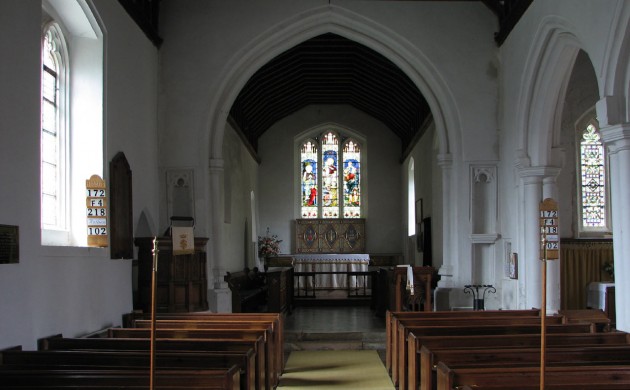
The chancel from the nave. The east window sits above the alter which has the two dedication plaques on either side. A later memorial tablet can be seen to the right of the alter on the south chancel wall beneath a list of the rectors. 1 February 2009
Following its publication, there was a deafly silence in the astronomical journals about what happened next. To find out more, it is necessary to turn to the minutes of the Council of the Royal Astronomical Society and to the correspondence on the Flamsteed Memorial that is held in the archives of the Royal Astronomical Society (RAS papers 57). From these we learn that that having secured his new window, the Rector was of the opinion that there was ‘hardly sufficient space in the chancel of the Burstow Parish Church for a monument of bust of Flamsteed’ (Tebb to Maunder, 2 May 1893). In light of this, at the Council meeting held on 10 November 1893, the following Report of the Flamsteed Memorial Committee was read by Mr Knobel and adopted:
That this Committee, understanding that a memorial window to Flamsteed has already been erected in Burstow Church, does not recommend any further action at Burstow.
That the Committee considers that it is desirable that a suitable memorial to Flamsteed be erected at the Royal Observatory Greenwich.
It was then resolved that before taking any further action that the above resolutions should be communicated to the Admiralty ‘enquiring of them what they are prepared to do in the matter’.
The Admiralty was not impressed. A preliminary reply dated 18 November to the society’s secretary, who at that time was Turner the Observatory’s Chief Assistant, began: ‘I really do not know how Council of RAS. can expect the Admiralty to give an intelligent reply on such an exceedingly scanty supply of information ...’. After seeking clarification from the Astronomer Royal (Christie), Euan MacGregor from the Admiralty then wrote formally to the Secretary on 14 December 1893 stating:
My lords desire me to request that you will inform the council that they are informed by the Astronomer Royal that he is of opinion that the question of considering the erection of any such memorial had better be deferred until after the completion of certain buildings now in progress [the New Physical Building].
It is surmised that the whole sorry saga influenced the inclusion of the bust of Flamsteed that not long after was placed over the front door of the New Building at Greenwich as part of a wider decorative scheme. An entry in Christie’s journal for 5 November 1894 (RGO7/30/26) states that ‘ Mr J Raymond Smith, sculptor called to arrange about bust of Flamsteed for N. wing of Physical Observatory and took away ivory medallion and engraved portrait of Flamsteed on loan’. An examination of the papers in RGO7/50 may shed more light on this.
Burstow did eventually get its medallion of Flamsteed with an English inscription – but not until the tercentenary of the Observatory in 1975. We learn from the The Royal Greenwich Observatory Report for 1975 January to September that the parish of Burstow held a Flamsteed Festival during the summer and that Dr. Hunter (the Observatory’s Director) spoke on the astronomical significance of Flamsteed’s work at a memorial lecture on 6 July, and read one of the lessons in Burstow Church at a Service of Thanksgiving on 13 July, when the Bishop of Kingston conducted Evensong and dedicated a new memorial tablet to Flamsteed. We further learn from the Journal of the British Astronomical Society, Vol. 87, p.443 that it was mounted on the South wall.
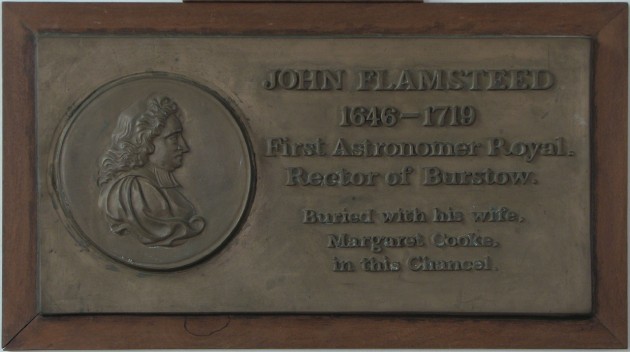
The tablet erected in 1975. It sits beneath a list of Rectors of the parish on the south wall of the chancel. 1 February 2009
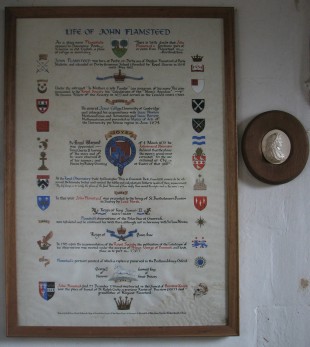
A poster about the life of Flamsteed and a small cameo. They are located at the west end of the nave under the organ loft. 1 February 2009
Flamsteed was also commemorated at Herstmonceux in 1975 when Her Royal Highness The Princess Anne, unveiled a newly carved stone bust of John Flamsteed that had been erected in the gardens having been sculpted by Mr. G. Elliott, a member of the staff of Ancient Monuments Division of the Department of the Environment stationed at Herstmonceux
Although the tercentenary of Flamsteed’s death in 2019 would have been an appropriate time for a memorial to be erected in Westminster Abbey where the astronomers Jeremiah Horrox, Isaac Newton, Edmond Halley, John Couch Adams, William and John Herschel and Stephen Hawking are already commemorated, none has been lobbied for nor sanctioned.
Further Reading
For a complete transcription of the wills of both John and Margaret Flamsteed (complete with notes) see: The Correspondence of John Flamsteed, The First Astronomer Royal: Volume 3: 1703–1719 pp.936–942 (Institute of Physics Publishing, 1997)
Image licensing information
The 1721 image of John Flamsteed is reproduced in compressed form and at a reduced size under the terms of a Creative Commons Attribution only licence CC BY 4.0 courtesy of Wellcome Library, London
© 2014 – 2025 Graham Dolan
Except where indicated, all text and images are the copyright of Graham Dolan
